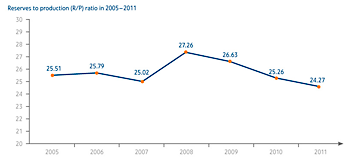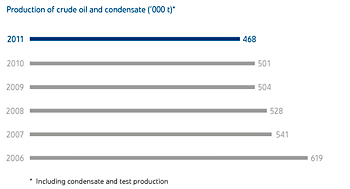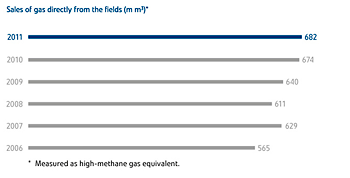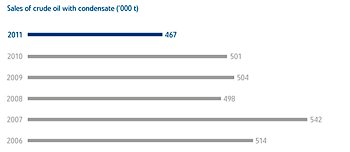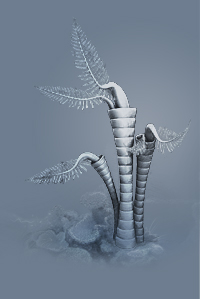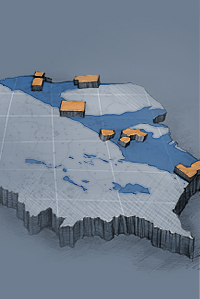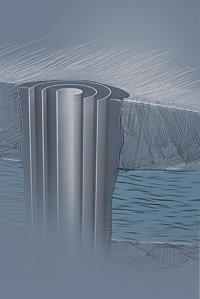Unconventional Gas Resources
The newest unconventional sources of gas are shale gas and tight gas deposits. While gas-bearing shale is encountered all over the world, it is commercially exploited only in the US, where shale gas production has been growing strongly – between 1996 and 2006 alone, it grew from 8.5 bn m³ to 25 bn m³.
In Poland, too, there has been growing interest in shale gas, which – according to estimates – is buried at depths ranging from 3,000 metres to 4,500 metres, within a sidelong belt stretching from central Pomerania to the Lublin Province, and within the foreland of the Sudeten Mountains. In recent years, the Ministry of Environment has awarded more than 100 licences for unconventional gas exploration to about 40 entities, of which 15 licences have been awarded to PGNiG.
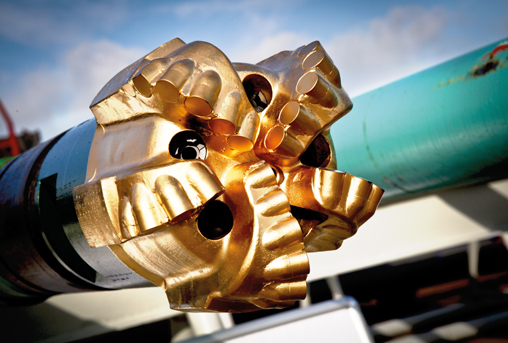
In March 2011, PGNiG drilled the vertical Lubocino-1 well on the play near Wejherowo, in northern Poland. Around 800 m of core was collected from the well and analysed. Subsequently, in the late August and early September 2011, fracturing operation was carried out in the Ordovician formations. Initial results of the fracturing operation and analysis indicate that gas may flow at satisfactory rates. Preparatory work and procedures to commence drilling of the horizontal Lubocino 2-H borehole are planned for 2012, when hydraulic fracturing operation has been performed in Ordovician formations. Further, similar preparations for fracturing in the Silurian formations in the vertical Lubocino-1 borehole are underway. Drilling of the Lubycza Królewska-1 borehole in the Tomaszów Lubelski licence area will also commence in 2012. This is the first exploration borehole designed to explore for the occurrence of shale gas in the areas of PGNiG’s licences in the southern part of the Lublin Province.
Resources/Reserves
Poland’s resources are evaluated by the Mineral Resources Commission and confirmed by the Ministry of Environment. As at the end of 2011, the combined reserves of natural gas and crude oil amounted to 748 m boe, including 594 m boe (92 bn m³) of gas and 154 m boe (21.1 m tonnes) of oil and condensate. In 2011, the total reserves to production ratio (R/P) was 24.3.
Production
In 2011, the production of natural gas and crude oil with condensate was 31.32 m boe, of which gas accounted for 89% and oil with condensate – for 11% of the total output. The respective production volumes were 4.33 bn m³ of natural gas (27.91 m boe) and 467.6 thousand tonnes of crude oil with condensate (3.41 m boe). Petroleum production is concentrated in north-western and south-eastern Poland and carried out by two PGNiG Branches – based in Zielona Góra and in Sanok.
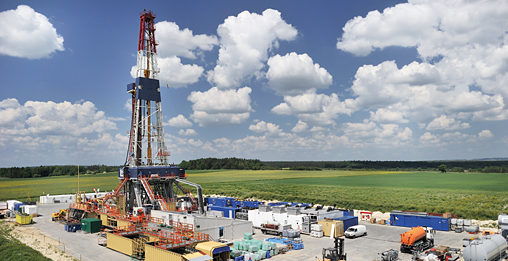
PGNiG produces two types of gas with different calorific values – high-methane and nitrogen-rich gas – at 68 production sites across Poland. In 2011, the Sanok Branch produced both high-methane and nitrogen-rich gas, as well as crude oil at 46 sites, including 26 gas production facilities and 20 oil and gas production facilities. The Zielona Góra Branch produced nitrogen-rich gas and crude oil at 22 sites, including 14 gas production facilities and eight oil and gas production facilities. Some portion of nitrogen-rich gas is further processed at the Denitriding Plants in Odolanów and Grodzisk Wielkopolski. Once nitrogen is removed, natural gas is fed into the high-methane gas system. In 2011, the conversion of nitrogen-rich gas into high-methane gas yielded 1.45 bn m³ of gas, up 6.6% on 2010. The process by-products include liquefied natural gas (LNG), liquid and gas helium, as well as liquid nitrogen.
With a view to maintaining the current hydrocarbon production volume or limiting its natural drop, in 2011 major remedial treatments were performed on a total of 36 wells whose technical condition prevented their further operation. Of that number, 31 wells flowed hydrocarbons at commercial rates. Of the other five, two wells are used as injectors, while one, which did not flow gas at commercial rates, was abandoned. The other two of the treated wells will be used by the underground gas storage facilities. In 2011 recovery techniques (including intensification initiatives) were applied on a total of 71 wells with a view to maintaining or improving production capacities of producing wells or to restore sub-surface extraction equipment to operating condition. Recovery techniques were also applied on wells operated by the underground gas storage facilities and on injectors.
Crude oil production is concentrated in western Poland, including currently the largest field – BMB (Barnówko-Mostno-Buszewo), which in 2011 accounted for 75% of total oil production in the country (341 thousand tonnes). In 2011, the volume of crude oil and condensate production was 467.6 thousand tonnes. This represents a year-on-year decrease of 32.7 thousand tonnes (6.6%), compared with 501 thousand tonnes of oil produced in 2010.
One of the major projects implemented in Poland in recent years to increase the production of oil and – to a lesser extent – of gas is the development of the Lubiatów-Międzychód-Grotów (LMG) fields in the vicinity of Gorzów Wielkopolski. As part of the project, PGNiG is now constructing the LMG Central Facility (to serve as a hub for collection, separation and treatment of reservoir fluids),as well as the Dispatch Terminal in Wierzbno, to support collection and shipment of crude oil. Crude oil will be transported by rail tankers and injected into the PERN pipeline, through which oil flows to Germany. Additionally, any surplus gas production will be transmitted via the pipeline running from the production site to the Grodzisk Denitriding Plant. The launch of production from the LMG field is scheduled for 2013. It is expected to result in a nearly two-fold increase in domestic oil production.
The PGNiG Group’s international expansion began in 2007 with the acquisition of an interest in the Skarv/Snadd/Idun exploration & production licence on the Norwegian Continental Shelf. Production from the Skarv/Snadd/Idun field is scheduled for launch in 2012. The target production volume in 2013 is approximately 400 m m³ of gas and approximately 490 thousand tonnes of oil. Natural gas will be transported to mainland Europe, whereas crude oil will be sold straight “from the wellhead”.
Sale
Natural gas is sold by PGNiG’s Exploration and Production segment directly from the fields (outside of the transmission system), from which it is supplied to specific customers via dedicated pipelines. Sales are transacted on market terms, and the delivery terms (including pricing) are agreed individually with the customers on a case-by-case basis, depending on the characteristics of a given project. The key group of customers buying natural gas directly from the fields are industrial users (such as Elektrociepłownia Zielona Góra SA, PGE Elektrociepłownia Gorzów SA, Zakłady Azotowe w Tarnowie-Mościcach SA or Arctic Paper Kostrzyn SA). This form of purchase is preferred by customers located in close proximity to the gas production sites. Sales of natural gas directly from the fields enable commercially viable development of gas reserves whose quality deviates from network standards and to attract customers in whose case deliveries of system gas are not feasible for technical or economic reasons.
In 2011, direct sales of gas accounted for approximately 5% of PGNiG’s total sales and amounted to 682 m m³, up by 1.2% on 2010. Direct sales from the fields are made both in the case of high-methane and nitrogen-rich gas – in 2011, 64 m m³ of high-methane gas and 618 m m³ of nitrogen-rich gas (measured as high-methane gas equivalent) were sold in this way.
PGNiG sells crude oil on market terms, pricing it by reference to the crude prices on international markets. Crude oil is sold through the following channels:
- via pipeline – to foreign customers,
- using wheel transport (by road and rail tankers) – to domestic customers.
In 2011, foreign customers accounted for 40% of the total volume of crude sold. The crude was transported to German refineries through the Druzhba pipeline.
Apart from non-tariff sales of gas directly from the fields and oil sales, PGNiG also sells a number of other products, such as helium, nitrogen, sulphur, condensate and propane/butane mix.
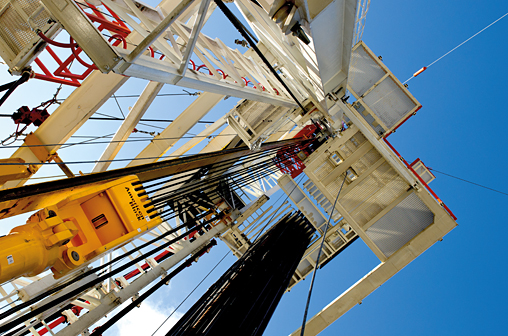
Investment Projects
In 2011, the Exploration and Production Segment incurred capital expenditure of PLN 2.5 bn.
The key projects implemented in 2011 include:
- Hydrocarbon exploration: 11 positive wells on which works continue, and 13 negative wells,
- Skarv project,
- LMG project,
- Grodzisk denitriding plant,
- gas pipeline to KGHM,
- fields’ development at Góra Ropczycka, Rylowa and Rajsko.
Other projects involve the development of gas fields, including producing fields, projects executed in order to sustain or restore hydrocarbon production rates, and projects related to the operation of the hydrocarbon production area.
